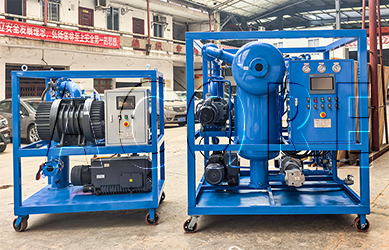The core principle of the Transformer Oil Filtration Machine is the three-stage
collaborative process of "vacuum dehydration + pressure filtration +
adsorption regeneration." First, the insulation oil to be processed is
pumped into the vacuum separation tank — the tank maintains a vacuum of -0.08
to -0.095 MPa (equivalent to a low-pressure environment above 3000 meters in
altitude). Water dissolved in the oil (about 100-300 ppm) and dissolved gases
(such as oxygen and nitrogen) quickly vaporize under low pressure, forming an
oil-water-gas mixed vapor. The vapor then passes through a condenser
(high-efficiency spiral tube or plate heat exchanger) and cools to 40-60°C. The
moisture condenses into liquid water and is discharged through a drain valve,
while the gas is removed by the vacuum pump system, achieving degassing and
dehydration of the oil (final water content ≤ 5 ppm, gas content ≤ 0.1%). The
second stage is pressure filtration. The degassed oil is passed through
multi-stage filter elements (such as 5-3 μm polymer fiber filters or stainless
steel mesh) to capture mechanical impurities (such as metal particles and
fibers), gums, and oxidation products, raising the oil cleanliness to NAS 4-6
level (ISO 4406 standard), ensuring no particle blockage in oil channels or
between electrodes. The third stage is adsorption regeneration (optional
module), which uses activated alumina, molecular sieves, or ion exchange resins
to deeply adsorb acidic substances (e.g., carboxylic acids), trace moisture
residues, and polar impurities in the oil, restoring its antioxidant properties
and dielectric strength (≥60 kV/2.5 mm).
1. Efficient Vacuum System: Using a combination of Roots pump + water ring pump
in series or a dry screw vacuum pump, the vacuum level is improved by over 30%
compared to traditional devices, and dehydration efficiency is increased by
50%. The moisture content in the oil can be reduced from 200 ppm to below 10
ppm within 30 minutes.
2. Intelligent Control Technology: Integrated online oil quality sensors (such
as moisture detectors, particle counters, and dielectric strength testers)
provide real-time feedback on oil parameters and automatically adjust vacuum
level, heating temperature (usually 60-80°C), and filtration flow rate,
preventing overheating oxidation or insufficient dehydration.
3. Material and Structural Optimization: The filter elements use a gradient
pore design (coarse outer layer filters large particles, fine inner layer
removes micro-particles), combined with aging-resistant fluororubber seals and
high-temperature resistant stainless steel tanks (temperature ≤ 120°C),
extending equipment life to over 10 years. The Transformer Oil Filtration Machine also can install oil
regeneration columns, using chemical adsorption or ionization technology to
restore aged insulation oil, reducing operation and maintenance costs.













 +8613206063693
+8613206063693 Rufus Huang
Rufus Huang sales@acorefiltration.com
sales@acorefiltration.com +8613206063693
+8613206063693 +86 23 8132 4618
+86 23 8132 4618